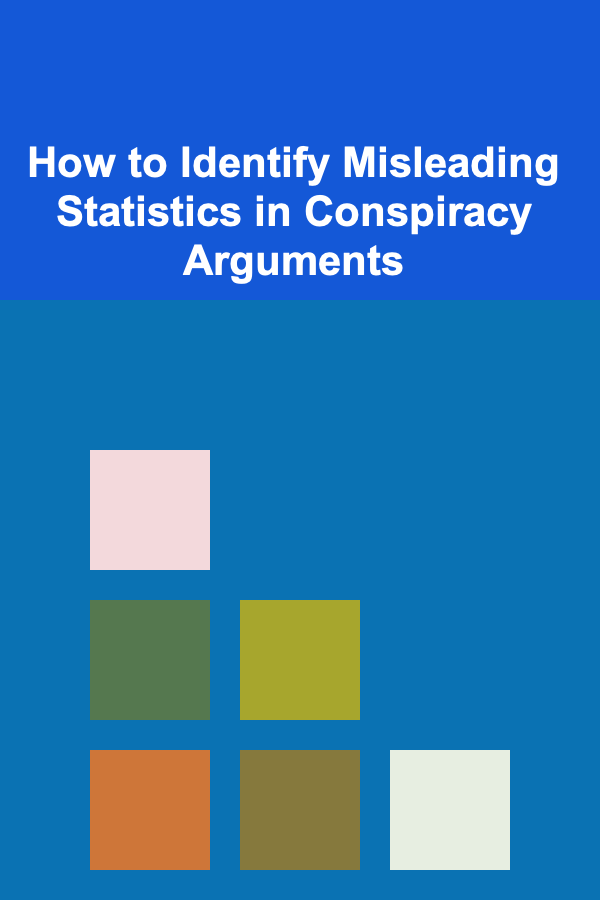
How to Identify Misleading Statistics in Conspiracy Arguments
ebook include PDF & Audio bundle (Micro Guide)
$12.99$6.99
Limited Time Offer! Order within the next:

Conspiracy theories often rely on statistical data to support their claims. However, these statistics are frequently misrepresented, manipulated, or used in misleading ways to deceive audiences. In this article, we will explore how to identify misleading statistics in conspiracy arguments, understand the techniques used to manipulate data, and develop critical thinking skills to assess the credibility of statistical evidence.
Introduction
Statistics play a crucial role in shaping opinions and beliefs in today's data-driven world. From healthcare to politics, statistics are used to validate arguments, support policies, and influence public opinion. However, not all statistics are reliable. In the context of conspiracy theories, statistics can be particularly problematic, as they are often presented in ways that seem legitimate but are designed to mislead or deceive. These theories can range from false claims about public health issues to elaborate hoaxes about global events or powerful groups controlling world affairs.
The misuse of statistics in conspiracy arguments can create a false sense of certainty and may lead individuals down dangerous paths of misinformation. It is crucial to learn how to identify misleading statistics, so we can evaluate the validity of claims and make informed decisions based on evidence rather than deception.
The Appeal of Statistics in Conspiracy Theories
Conspiracy theories thrive on uncertainty and distrust of official narratives. By presenting statistics, conspiracists give the illusion of objective, scientific proof to their claims. Numbers can be persuasive, as they are often perceived as more credible than anecdotal evidence or personal opinions. When presented in a convincing manner, statistics can lend a sense of authority to even the most far-fetched claims.
However, this trust in numbers can be exploited. Conspiracy theorists often use statistics selectively, cherry-picking data that aligns with their narrative while ignoring data that contradicts it. They may also present statistics without proper context, manipulate figures, or use complex data to confuse their audience into accepting faulty conclusions.
Understanding how statistics are misused in conspiracy arguments can help us critically assess the validity of these claims and avoid being misled.
Common Techniques for Misleading Statistics in Conspiracy Arguments
1. Cherry-Picking Data
One of the most common techniques for misleading with statistics is cherry-picking data. This involves selecting specific data points that support a particular argument while ignoring data that contradicts it. Conspiracy theorists often focus on anomalous or rare occurrences and present them as representative of a broader trend, leading people to believe in a connection that may not exist.
For example, a conspiracy theorist might point to a few instances of rare adverse reactions to a vaccine and use them as evidence that the vaccine is dangerous. However, they may ignore the much larger body of data showing that the vaccine is safe for the vast majority of people.
2. Misleading Averages
Another tactic used in conspiracy arguments is the manipulation of averages, particularly the mean, median, and mode. Averages can be powerful tools for summarizing data, but they can also be misleading when used incorrectly.
For instance, if a group of people has a few extremely high or low values, the mean (average) may not represent the typical experience. Conspiracy theorists may present the mean as a reflection of the entire population, when in fact, the median (middle value) or mode (most common value) may provide a more accurate representation.
Consider a conspiracy theorist claiming that the average income in a particular country is extraordinarily high. By focusing on the mean income, they may ignore the vast income inequality that skews the data. The median income would give a more accurate picture of what most people are actually earning.
3. Correlation Does Not Imply Causation
A classic mistake in statistical reasoning is confusing correlation with causation. Just because two events or variables are correlated does not mean that one causes the other. This logical fallacy is often used in conspiracy theories to suggest that one event must have caused another, even when no causal relationship exists.
For example, a conspiracy theory might claim that the increase in global temperatures correlates with the rise of certain technologies or political events. While these two variables might be correlated, that doesn't mean that one caused the other. There could be other factors at play, and further investigation is needed to determine causality.
Conspiracy theorists often use correlation to support their claims, even when there is no clear causal link. It is important to look for evidence of causation, such as controlled experiments or longitudinal studies, to establish a true cause-and-effect relationship.
4. Overgeneralization
Overgeneralization occurs when a limited set of data or experiences is applied to a broader population or context. This is a common technique used in conspiracy theories to suggest that a few isolated incidents are representative of a much larger, often hidden, phenomenon.
For example, a conspiracy theorist might point to a small number of wealthy individuals or organizations and argue that they control the global economy. While it is true that wealth inequality exists, overgeneralizing the power of a few people to control everything can be misleading. This technique plays on the human tendency to find patterns in complex systems, even when no meaningful pattern exists.
5. Misleading Graphs and Visualizations
Graphs and visualizations are powerful tools for communicating data, but they can also be easily manipulated to mislead audiences. By altering the scale of the axes, changing the range of the data, or selectively displaying certain data points, conspiracy theorists can create misleading graphs that appear to support their claims.
For instance, a graph showing the rise of a particular phenomenon over time may exaggerate the trend by starting the Y-axis at a value other than zero, making the increase look more dramatic than it really is. Similarly, selective data points may be emphasized, leaving out critical context that changes the interpretation of the graph.
6. Small Sample Sizes
Conspiracy theories often rely on small sample sizes, which can lead to inaccurate or unreliable conclusions. A small sample may not be representative of the larger population, making any conclusions drawn from it suspect.
For example, a conspiracy theorist may conduct a survey of 100 people and use the results to make sweeping claims about the views of an entire population of millions. This small sample size is not sufficient to generalize the findings to a broader group, yet the statistics may still be presented as though they are universally applicable.
7. False Equivalence
False equivalence occurs when two things are compared as if they are equivalent, despite significant differences between them. Conspiracy theorists often use this tactic to make comparisons that are misleading or nonsensical.
For example, a conspiracy theorist might compare two unrelated events---such as the outbreak of a disease and a political scandal---suggesting that they are part of the same larger conspiracy. While both events may have occurred around the same time, drawing a direct equivalence between them without evidence is misleading and does not provide a solid basis for a conspiracy argument.
How to Identify Misleading Statistics
1. Check the Source
The first step in identifying misleading statistics is to examine the source of the data. Reliable statistics come from reputable sources such as government agencies, universities, or established research organizations. If the statistics come from an unknown or biased source, it is important to be cautious.
Look for peer-reviewed studies, official reports, or data from respected organizations. Avoid statistics from sources with a clear agenda or those known to promote misinformation.
2. Look for Context
Statistics can be misleading when they are presented without proper context. Always ask questions like:
- What is the sample size?
- What are the time frames for the data?
- How was the data collected?
- Are there other variables that could explain the findings?
Without context, statistics can be distorted to fit a narrative. Make sure that the data is not being presented in isolation and that it accounts for all relevant factors.
3. Scrutinize the Methods
To evaluate the validity of statistical data, it is essential to understand the methodology behind it. Conspiracy theorists may use dubious methods or cherry-pick data to support their claims. Look for transparency in how the data was collected, analyzed, and interpreted. If the methodology is unclear or the analysis seems overly simplistic, the statistics may be misleading.
4. Question Correlations
As mentioned earlier, correlation does not imply causation. Always question whether the correlation presented in a conspiracy argument is meaningful. Look for studies that show a clear causal link between two variables, rather than just a correlation. Correlation-based arguments are often used in misleading ways to suggest that one thing causes another without solid evidence.
5. Beware of Emotional Appeals
Conspiracy theorists often use statistics to create emotional appeals. They may present data in a way that is designed to trigger fear, anger, or anxiety, manipulating the audience into accepting their narrative. Be cautious of statistics that seem intended to provoke strong emotional reactions rather than to present factual, unbiased information.
Conclusion
Statistics can be a powerful tool for understanding the world, but they can also be easily manipulated to deceive and mislead. Conspiracy theorists often use statistical data to support their arguments, but they frequently employ techniques such as cherry-picking, misleading averages, and false equivalences to distort the truth.
By developing critical thinking skills, questioning the sources and methods behind statistical claims, and being aware of common techniques used to manipulate data, we can better identify misleading statistics in conspiracy arguments and make informed decisions based on reliable information.

How to Clean Your Home's Exterior: Tips for Windows, Doors, and Siding
Read More
How to Plan a Fun Family Movie Night on a Budget
Read More
How to Remove Hard Water Stains from Bathroom Surfaces
Read More
How to Develop Augmented Reality (AR) for Healthcare Professionals
Read More
How To Create Engaging Art Projects for Young Children
Read More
How to Fold Origami Flowers That Look Real
Read MoreOther Products

How to Clean Your Home's Exterior: Tips for Windows, Doors, and Siding
Read More
How to Plan a Fun Family Movie Night on a Budget
Read More
How to Remove Hard Water Stains from Bathroom Surfaces
Read More
How to Develop Augmented Reality (AR) for Healthcare Professionals
Read More
How To Create Engaging Art Projects for Young Children
Read More